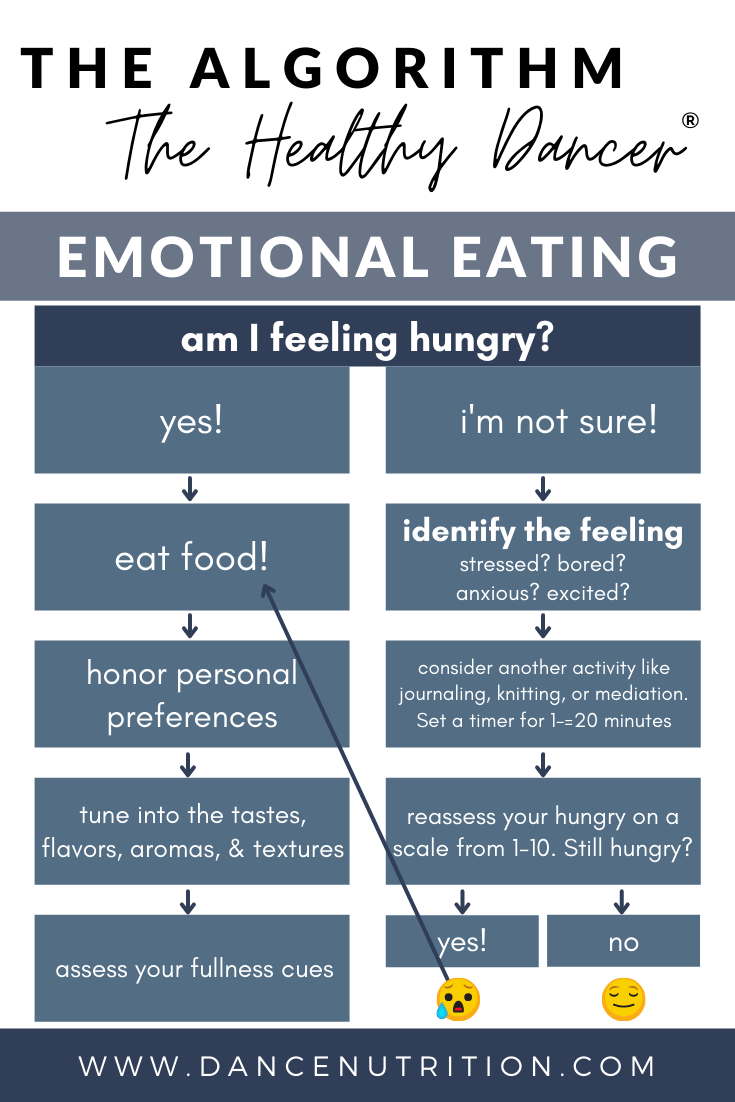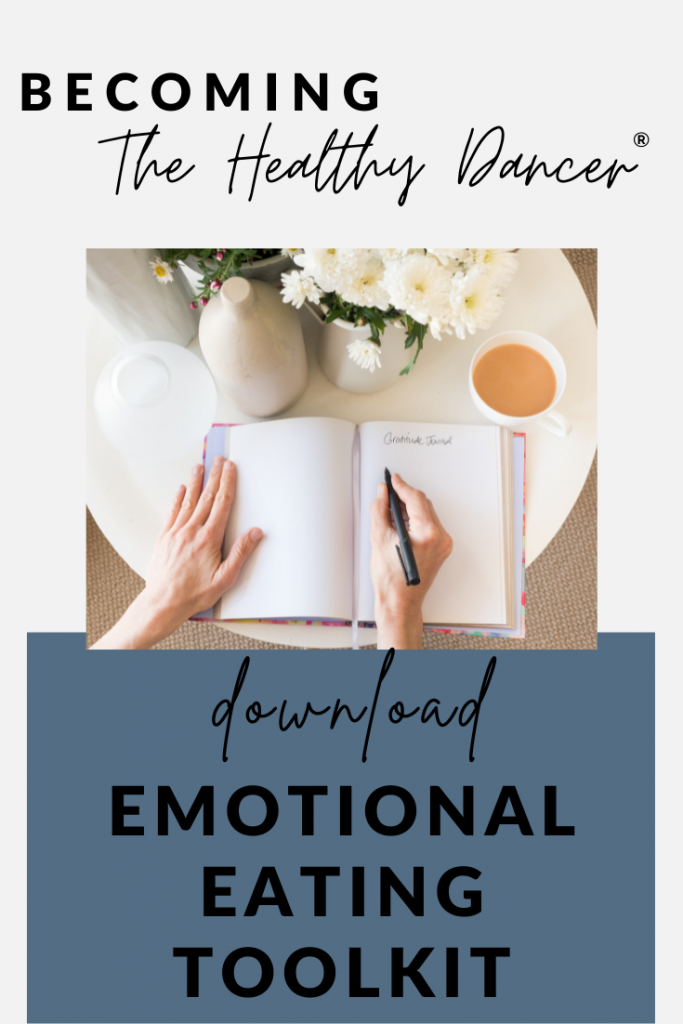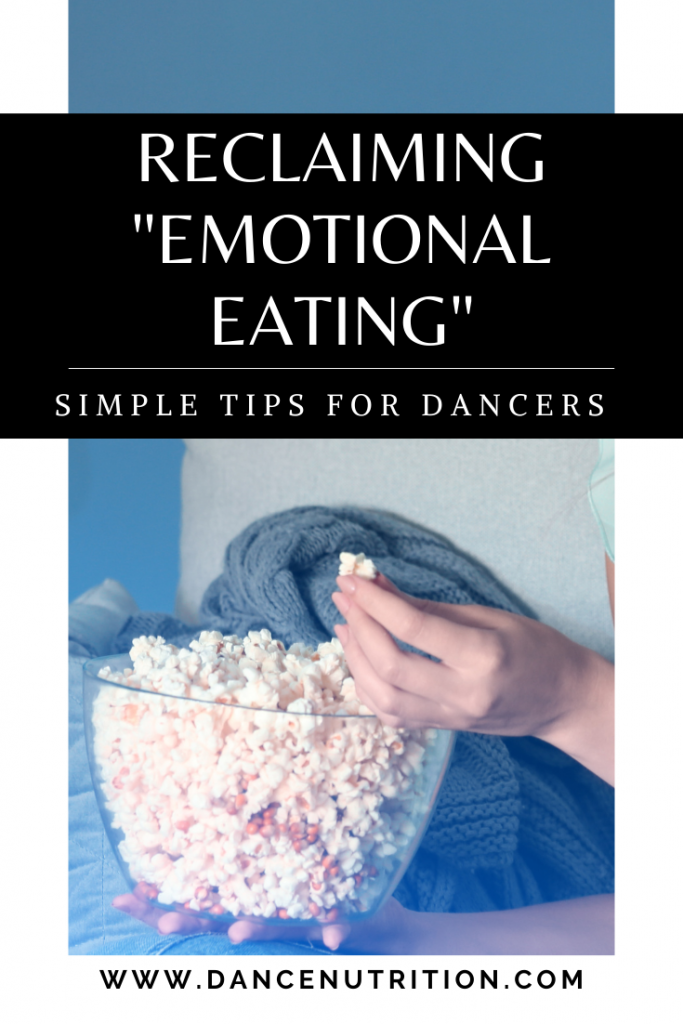Do you find yourself eating in response to emotions? You’re not alone— let’s talk about it.
I don’t love the term “emotional eating.” That phrase often conjures an image of someone on the couch, upset, spoon-deep in a pint of ice cream— cue guilt and shame. But that picture is shaped by diet culture and does more harm than good.
Food and emotion are meant to be connected. Our eating habits reflect everything from our mood and memories to our social lives and stress levels. The act of eating is emotional, and that’s not a flaw. It’s a fact of being human. This connection runs even deeper for dancers, who exist in high-pressure, body-conscious environments.
In this article, we’ll explore:
- The #1 reason dancers turn to food emotionally
- A practical, compassionate roadmap for navigating emotional eating
- Why reclaiming your right to eat emotionally might be your first step to a more supportive relationship with food.
Don’t forget— scroll to the end to grab your free copy of The Healthy Dancer® Complete Guide to Emotional Eating.
Why Do Dancers Eat Emotionally?
Emotional eating is a normal response to discomfort— stress, anxiety, sadness, boredom— or even joy. Sometimes, food offers a temporary distraction. Other times, it enhances celebration. For example, dessert after a long rehearsal may not come from physical hunger, but it just feels good. That’s not wrong— it’s human.
Common emotional eating scenarios include:
- Reaching for snacks when you’re bored or under-stimulated.
- Eating to amplify moments of excitement, celebration, or reward.
- Turning to food as a soothing ritual after a stressful day.
- Seeking comfort during stress or sadness.
- Using food to avoid uncomfortable feelings like frustration.
Are Dancers More Prone to Emotional Eating?
Yes. Dancers exist in a uniquely high-pressure environment where performance, perfectionism, and body awareness collide. This can lead to:
- Performance pressure and uncertainty around auditions or casting.
- Personality traits like perfectionism or sensitivity to body image.
- A lack of emotional outlets, especially when injured or during off-seasons.
Dancers are visual artists— trained to express emotions physically through movement, but not always to process them internally. That disconnect can make it harder to recognize and manage feelings outside the studio. As a result, dancers may turn to food to fill the gap—a distraction when discomfort surfaces.
When Is It Problematic?
Let’s be clear: emotional eating is not a failure. It’s a coping tool— and not inherently harmful. The problem is when food becomes your only tool available. If food is your go-to for every emotional wave, you may miss what your body or mind needs: comfort, connection, distraction, stimulation, or rest.
It’s also compounded by the shame we’ve been taught to feel about “eating our feelings.” This intensifies food guilt, leading to diet cycling and rebound eating. Some dancers even feel “addicted” to food during these moments (a concept I dive into here).
Reclaim Emotional Eating
I want you to connect with food emotionally. I want you to take comfort in it, feel pleasure from it, and trust that those feelings are valid.
Being mindful of what’s driving your desire to eat is important. Are you responding to your body’s true needs, or are you using food to mask something deeper? Sometimes, our emotions are signaling a need beyond food. Here are some possibilities:
- Sensory gratification— something to engage your senses (a walk, music, a hug)
- Distraction— something to take your mind off stress (journaling, creativity, exercise)
- Comfort— something that calms you (talking to a friend, a hot bath)
When we allow food to be emotionally satisfying, we build a more mindful, sustainable relationship with eating. That means honoring hunger and fullness cues— even when eating emotionally.
So, how do you build that trust?
5+ Strategies to Navigate Emotional Eating with Confidence
#1: Build a Foundation of Nourishment
You cannot address emotional eating if you’re chronically undernourished. Whether it’s due to busy schedules or intentional restriction, under-eating amplifies emotional responses to food. This can lead to rebound hunger (extreme hunger)— making it hard to stop eating even when feeling full.
Your body deserves consistent nourishment. Removing the point of deprivation will help you to regain the reins on your relationship with food.
Ask yourself:
- Are my meals satisfying and consistent?
- Are they enough to meet my body’s needs?
- Do I fear certain foods like dessert or carbs?
If you’ve answered yes to the third question, you may be living by food rules— restrictive beliefs that make food feel emotionally charged. Rebuilding trust starts by eating enough and letting go of labels like “good” or “bad” foods.
Begin by listing foods you avoid because you or someone else labeled them as “forbidden” or “unhealthy.” Incorporate these foods into your daily meals as part of pleasant and satisfying experiences. Here are a few more resources to help:
#2: Get Curious About Your Hunger— and Emotions
You’ll need to first learn how to differentiate emotional hunger from physical hunger. Emotional hunger often masks unmet needs. To decode it:
- Pause for 20 minutes. Check in with your body. What are you feeling? Can you rate your hunger on this hunger scale?
- If food still feels right, honor that— without guilt.
Tuning into your emotions is not about denying food— it’s about expanding your options. Sometimes, you need food. Sometimes, you need something else. The Healthy Dancer® Emotional Eating Algorithm is a quick flowchart that I want you to keep on hand.

#3: Release the Pressure to Eat Perfectly
Perfectionism can fuel all-or-nothing thinking: “If I eat emotionally once, I’ve failed.” But healing your relationship with food means embracing flexibility. If you’re a perfectionist, here’s an article to build more realistic expectations.
Contrary to what diet culture says, a healthy relationship with food is not simply “eating when hungry and stopping when full.” It involves a dynamic, judgment-free approach that honors your body’s cues— even when they’re messy.
Mindful eating can help. It encompasses the practice of making food a satisfying experience. As you eat, tune into flavors, textures, and satisfaction. The more you eat past comfortable fullness, the less satisfying food feels. Most importantly, know that food can be delicious today, and again tomorrow. You don’t need to “get it all in before it’s gone.”
#4: Reframe Emotional Eating as a Valid Coping Strategy
Emotional eating isn’t “bad.” It’s one of many ways you’ve adapted to process emotion— just like journaling or listening to music. You’re not a bad person for eating emotionally. You’re a person learning to meet your needs.
The real question is: is this action helping you right now?
There’s power in reframing. When you stop moralizing food, you open the door to self-compassion and more diverse coping skills.
#5: Create and Use Your Emotional Toolkit
If you’re turning to food at the end of a stressful day, that’s okay. But if you feel like food is your only relief, it might be a temporary distraction from what you truly need.
Ask yourself:
- What else might feel good right now?
- What might leave me feeling more grounded an hour from now?
Your emotional toolkit might include:
- Listening to music
- Calling a friend
- Improv dancing
- Taking a hot shower or epsom bath
- Simply resting
#6: Seek Professional Support and Resources
If you’re feeling stuck, reach out. As a registered dietitian nutritionist and dancer, I created The Healthy Dancer® to help dancers like you navigate emotional eating with grace, clarity, and lasting support.
Nourish The Healthy Dancer® is a series of supplemental self-study courses designed to sustain the work of The Healthy Dancer® lifestyle. Since dancers often turn to food to feel in control when so much around auditions, casting, and company promotions feel out of control, this self-study course teaches dancers how to master body attunement as a tool to navigate emotional eating and alleviate feelings of food guilt.
The Bottom Line:
You’re not “doing it wrong” if food feels emotional. And you’re not alone if you’ve turned to food to feel something—anything—amid the highs and lows of dancer life. You deserve nourishment without shame, connection without guilt, and the freedom to experience food as part of a full, emotionally rich life.





